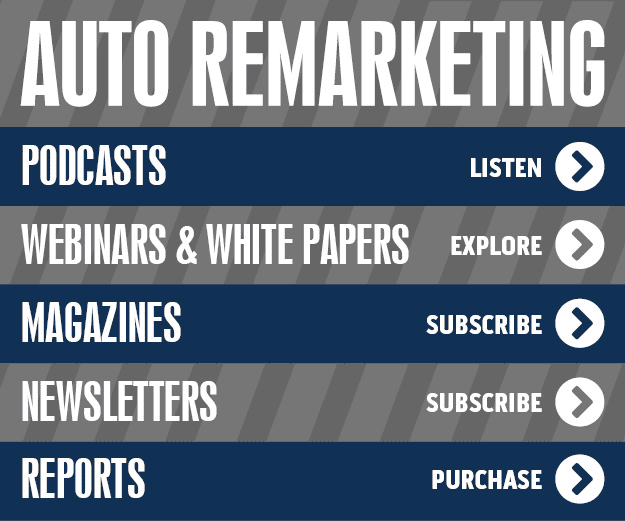Subprime auto finance provider Western Funding has a new underwriting system that the company claims will cut the time of getting funds to dealerships in half.
The company recently announced the release of its new automated underwriting system, which is designed to improve the verification, processing and management of deals and adds automated queues and workflows to shorten funding times.
“We’ve listened to our dealers and recognize that the timeliness of cash flow is one of the most important factors when selecting a lender. We are dedicated to providing our dealer base quick funding to help them grow too,” Guerin Senter, president of Western Funding, said in a press release.
Western Funding developed this new underwriting system during the first few months of this year, starting the process in January. It activated the system in May and hopes for increased efficiency and accuracy in the underwriting process.
Over the past two years, Western Funding has grown significantly, building a portfolio of more than $100 million. The company, which as been in the subprime auto loan industry for more than 50 years, embraces new technologies to make the lending process faster and more profitable.
Westlake Financial Holdings, the parent company of Western Funding, hopes that the system will continue to improve the process of sending funds to their dealer base. WFH president Ian Anderson said in the release that the company is “very supportive of Western Funding’s future.”
With retail prices rising, Experian Automotive reported the average loan amount and monthly payment for used and new vehicles continued to trend upward.
According to its most recent State of the Automotive Finance Market report, Experian indicated on Thursday that the average loan amount for a new vehicle reached $30,032, an all-time high. Meanwhile, the average loan amounts for used vehicles stood at $20,723 for vehicles retailed at franchised dealers and $16,124 for units turned at independent stores — both Q1 highs.
To help consumers keep payments within their budget constraints, Experian highlighted that leasing reached its highest level on record. Leasing accounted for 31.1 percent of all new-vehicle transactions during the first quarter of 2016.
Additionally, while leasing is still predominately an option for new-vehicle financing, analysts noticed used-vehicle leasing increased 2.1 percent from a year ago.
“The continued rise in new vehicle costs have kept many consumers exploring options to keep their monthly payments affordable,” said Melinda Zabritski, Experian’s senior director of automotive finance.
“As long as vehicle prices continue to rise, we can expect leasing rates to grow along with them,” Zabritski continued. “However, consumers need to understand the nuances of their lease agreements and make sure that leasing fits their lifestyle.”
Findings from the report also showed an increase in the percentage of prime consumers who shifted to the used vehicle market. In fact, prime borrowers elected to purchase a used vehicle more than 54 percent of the time in Q1 2016, a 4.8 percent increase from the previous year.
However, the opposite is true for the new-vehicle finance market. While the percentage of subprime borrowers in the total loan market decreased 1.1 percent, Experian found that the percentage of subprime borrowers for new vehicles saw a 5.5 percent increase from a year ago.
“The record highs we have seen in vehicle prices also have had a significant impact on the loan market,” Zabritski said. “For example, the number of prime borrowers who switched to leasing has driven an increase in the percentage of subprime borrowers shown in the new vehicle segment.
As a result, we will continue to see consumers view used vehicles, longer-term loans and leasing as a way to keep payments affordable,” she went on to say.
Experian mentioned that shifts in risk tier distribution for new and used vehicles also are reflected in average credit scores. The average credit score for a new vehicle loan was 710, down three points from the previous year, while the average credit score for a used vehicle loan was up three points to 645.
Additional insights from the Q1 2016 report:
• The percentage of new vehicles financed was 86.3 percent, up 1.6 percent from a year ago.
• The average loan terms for new vehicles, used vehicles from franchise dealers and used vehicles from independent dealers all increased by one month, reaching 68, 66 and 58 months, respectively.
• The average interest rates were 4.79 percent for a new vehicle loan, 7.81 percent for a used vehicle loan at a franchise dealer and 12.22 percent for a used vehicle loan at an independent dealer.
• Average monthly payments for new vehicle loans reached an all-time high — $503. Average monthly payments for used vehicle contracts originated at a franchised dealer stood at $376 and $351 for contracts originated at an independent dealer.
Jack Tracey, executive director of the National Automotive Finance Association, described the relationship between member finance companies and the Consumer Financial Protection Bureau as not exactly deteriorating but not necessarily improving significantly, either. He explained to SubPrime Auto Finance News the reason why.
“The industry would like to feel like it’s working cooperatively with the CFPB to improve situations and conditions in the marketplace now,” Tracey said. “But pretty much as it’s been from the beginning, everyone is continually concerned as to when the next shoe is going to drop or what is going to be the next thing the CFPB is going to focus on.
“In many cases, the CFPB’s approach to regulation is punitive rather than working with the industry,” he continued.
The CFPB certainly remains active, and it’s one of the major discussion points the NAF Association has in store for its 20th annual Non-Prime Auto Financing Conference. For the second year in a row, the organization is welcoming more than 350 finance company executives, service providers, legal experts and regulators to the Dallas/Plano Marriott Legacy Town Center in Plano, Texas, for the event that runs Wednesday through Friday.
Along with what might be percolating within the walls of the CFPB in Washington, D.C., Tracey also mentioned that another element to how the bureau is wielding its influence is coming to light for NAF Association members.
“I would also say there’s becoming an increased awareness of the CFPB working with various states so that a state will approach an issue rather than the CFPB,” Tracey said. “Attorneys general and regulators at the state level we believe are working in tandem with the CFPB, so there are multiple agencies and regulatory bodies that are approaching the industry with concerns.
“The industry is becoming increasingly aware of it and concerned about it,” he added.
What NAF Association members are also aware of is the steady rise of delinquencies. But finance companies and industry watchers do not appear to be sounding alarms.
As fourth quarter outstanding auto loan balances reached the highest level on record since Experian Automotive began publicly tracking the data in 2006, Melinda Zabritski reminded the industry how to view a slight uptick in 60-day delinquencies.
According to its most recent State of the Automotive Finance Market report, Experian determined that 30-day delinquencies dropped across the board during the fourth quarter, pushing the overall rate to 2.57 percent from 2.62 percent a year ago. Conversely, 60-day delinquencies rose from 0.72 percent to 0.77 percent over the same time period.
Experian mentioned that all lender types saw increases in the percentage of loans that were 60 days delinquent with the exception of credit unions, which remained flat year-over-year. But Zabritski — the senior director of automotive finance for Experian — pointed out that the percentage of loans that were 60 days delinquent is still below the percentage in Q4 2007, when it was 0.8 percent.
The report found that finance companies make up the largest portion of the $6.8 billion in loan balances that were 60 days delinquent. Finance companies — the category of originators that Experian said book vehicle installment contracts but do not generate commercial deposits — hold nearly 45 percent of these balances with a total dollar volume of $3.04 billion. They are followed by banks ($1.8 billion), captive finance companies ($1.2 billion) and credit unions ($737 million).
“While rates in the more severe delinquency category are up, it’s important to note that the increases are modest and relatively low from a historical perspective,” Zabritski said.
“Also, given that we’ve seen an increase in loans to subprime and deep-subprime consumers, it’s natural to see a slight uptick,” she continued. “Although not yet a cause for concern, the industry should keep an eye on this metric to see how it trends in the quarters to come.”
As Zabritski referenced, Experian reported that subprime and deep subprime contracts accounted for 20.3 percent of all open automotive loans, compared with 20.8 percent in Q4 of 2014.
After conferring with NAF Association members, Tracey offered a similar assessment.
“I would say there’s a focus on delinquency. I wouldn’t say it’s a huge level of concern, but there’s increased focus on it,” he said. “In my opinion, part of the concern is that it’s not the number of delinquent accounts, it’s the amount. Terms were extended so amortization is slower.
“Overriding that concern on anything that’s delinquent now is vehicle values,” Tracey continued. “They’re trending down because of the influx of leased vehicles into the market and other conditions in the remarketing area that cause the collateral values to be down.
“People are watching it because if vehicles are repossessed, there’s going to be an increased loss because of used-car values being down,” Tracey went on to say.
If account holders manage to maintain their payments, Tracey is confident the auto financing market will continue to hold its important place in the turning of both new and used vehicles at the paces the industry has seen during the past couple of years.
“I would say the principle reason car sales are exceeding or at least meeting the high expectations is because of financing,” Tracey said. “With lower rates available and a competitive marketplace, people are able and willing get into new and used cars.
“There’s a lot of competition in the non-prime area,” he continued. “Even in the higher rates that need to be charged with non-prime, it’s competitive, so to a certain extent there’s downward pressure on those rates, too. The competitive environment and the availability of financing at lower rates is driving the auto industry. If the auto financing industry pulls back it will have a pull-back effect on car sales as well.”
Conference highlights
Wednesday
3:45 – 4:30 p.m.
NAF/AFSA Non-Prime Auto Financing Survey
Dwayne Furmidge, Director Americas, Benchmark Consulting International will share an overview of the NAF Association’s 20th Annual Non-Prime Automotive Financing Survey. This session will provide insights that are not available anywhere else.
Thursday
3:45 – 4:30 p.m.
Economic Forecast – Used Car Market
Tom Webb, chief economist at Cox Automotive, will discuss auctions’ trends in pricing, volume, and buyer and seller behavior indicate about the overall automotive marketplace — from manufacturers, to dealers, to lenders, and to retail customers. This session will translate market data on used vehicles into information executives can use.
11:15 a.m. – 12 p.m.
ABS Markets
Amy Martin, team leader and senior director in the Structured Finance Ratings Group at Standard & Poors will recap current market trends in non-prime financing. Information will be provided on issuance volume, collateral and ratings performance and Standard and Poors’ outlook for the auto loan ABS market.
Friday
8:30 – 9:30 a.m.
Update from Committee on Financial Services
Rep. Jeb Hensarling is set to address the conference on House Financial Services Committee activity including committee interaction with the CFPB, pending last-minute demands on Capitol Hill.
9:30 – 10:15 a.m.
Owe Canada: How to take Advantage of the Growing Non-prime Market in Canada
Neil Abbott, partner at Gowling WLG in Canada, will highlight how below-prime lending is much more common today in the Canadian economy and it may be an opportune time for U.S. lenders to consider buying a Canadian loan portfolio or investing in Canada. This session will cover the similarities and differences between Canada and U.S. non-prime lending markets.
Subprime automotive financing technology firm Auto Credit Express has been acquired by Internet Brands — a company that includes vehicle listing provider CarsDirect — according to an announcement posted on Wednesday morning.
Executives said the deal immediately bolsters Internet Brands’ presence in the subprime automotive category and creates one of North America’s largest full-service subprime automotive solution providers, serving both consumers and dealerships. Internet Brands is a fully integrated online media and software services organization focused on four high-value vertical categories: automotive, health, legal and home/travel.
Auto Credit Express has connected credit-challenged consumers with automotive financing from dealerships and other lending partners since its founding in 1999. Beyond loan matching, the company offers dealerships advanced subprime training, propriety online tracking software, and an expert lead system.
“We’ve always admired Auto Credit Express’ commitment to unwavering business ethics and a top-notch customer experience — values that are shared by Internet Brands,” said Todd Dearborn, vice president of sales at Internet Brands’ automotive division. “We look forward to developing innovative new ways to serve the large and growing subprime automotive market as we join forces."
Auto Credit Express joins Internet Brands' rapidly growing automotive division, which currently serves the subprime automotive market through its flagship CarsDirect business. In recent years, subprime loan matching has become a fast-growing business line for CarsDirect, complementing its new- and used-vehicle lead products.
“Internet Brands’ unparalleled automotive expertise and proven track record of growing the businesses they acquire makes us confident that they’re the ideal partner for us,” said Rich LaLonde, founder of Auto Credit Express.
Added Jack Lintol, general manager at Auto Credit Express: “The future is bright for Auto Credit Express as we work closely with the Internet Brands team to take our business to the next level and serve our valued customers even better than ever before.”
The Auto Credit Express brand and existing product offerings will be retained post-acquisition, and the company will continue to operate from its headquarters in Auburn Hills, Mich.
Auto Credit Express was represented by Quarton International in the transaction.
Successful chief executive officers often emphasize that their companies are only as successful as the quality and dedication of their managers and other crucial personnel.
In an effort to highlight the critical team members who are helping finance companies, dealerships and other service providers flourish as well as those professionals who are making an impact throughout the industry, SubPrime Auto Finance News is taking nominations for its next project to be published in our July/August issue.
For what’s being dubbed “Trailblazers, Innovators & Disruptors,” we’re asking the auto finance community to share stories of non-CEO executives who are:
—Blazing a new trail in the industry
—Innovating with fresh ideas and business solutions
—Disrupting the status quo with unique strategies, technologies and applications to grow and improve profitability
Through 5 p.m. EDT on June 17, nominations along with explanations as to why the professional is successful can be sent to SubPrime Auto Finance News senior editor Nick Zulovich via email ([email protected]).
Here are some sample questions to be answered to enhance nominations:
—What existing process did this individual revamp or what problem did he/she solve that the industry struggled to overcome?
—When presented with a challenge, how did the individual respond?
—How much did the company benefit from the work of this individual?
Along with responses to those questions, please share a company logo and a high-resolution head shot of the professional.
“Coming off of the success with a similar project we published earlier this year — “The CEO Issue” — we’re now taking an expanded look at the talented individuals who might not yet be making headlines but are the reasons why their company is enjoying success,” said Bill Zadeits, publisher of SubPrime Auto Finance News.
“We hope this issue captures why subprime auto financing is one of the most innovative and pioneering pieces of the entire industry,” Zadeits continued.
Along with highlighting “Trailblazers, Innovators & Disruptors,” the July/August edition of SubPrime Auto Finance News also will share a midyear industry report detailing what’s happened so far in 2016 and what could be ahead during the remainder of the year.
So if you know of an industry professional who should be included in our next issue putting the spotlight on “Trailblazers, Innovators & Disruptors,” send your nominations and responses to the sample questions listed above to SubPrime Auto Finance News senior editor Nick Zulovich ([email protected]).
And if you don’t already have one, get your free subscription by going to www.autoremarketing.com/subprime/subscribe.
A new study by LendingTree showed millennials in three Midwestern areas are seeking auto loans more often than their counterparts in any of the nation’s top 50 cities.
Dealerships and their finance companies might be seeing more activity from consumers between 18 and 34 years of age percolating in Memphis, Tenn., Milwaukee and St. Louis, according to LendingTree’s analysis released on Wednesday.
LendingTree analyzed auto loan requests received from May 15 of last year and May 15 of this year, along with requests from the total population of auto-loan-seekers in the same period. The city ranking is created from the percentage of all purchase auto loan requests that were submitted by consumers in the millennial generation.
Memphis topped the list with 41.98 percent of all auto loan requests coming from millennials, followed by Milwaukee at 40.68 percent and St. Louis at 37.88 percent. Average auto loans to young borrowers in those cities were $11,791.22, $11,413.42 and $12,352.36, respectively.
On average, 33 percent of all auto loan requests through LendingTree come from applicants under 35 years old. Nationally, their auto loans average $14,825.34, compared to $17,938.74 for applicants 35 and older.
“With unemployment among millennials improving, coupled with lower interest rates and low gas prices, the share of millennial auto loan requests is on the rise," said Doug Lebda, founder and chief executive officer of LendingTree.
“Although the share of millennial auto loan requests is relatively lower in densely populated urban areas, the auto market appears to be enticing aging millennials,” Lebda continued.
Despite the widely held belief that millennials will become an increasingly smaller segment of the total vehicle-buying population, LendingTree insisted the share of auto loan requests from millennials has been increasing in recent years. The company indicated the share of millennial auto loan requests has climbed from roughly 27 percent in early 2013 to about 34 percent in 2016, suggesting a return of younger buyers to the car market.
|
Metropolitan Statistical Area (Top 10)
|
% of Total Car Buyers
(Under 35)
|
Average Offered Loan Amount
(Under 35)
|
% of Total Car Buyers
(35+)
|
Average Offered Loan Amount
(35+)
|
Total Average
Loan Amount
|
|
Memphis, Tenn.
|
41.98%
|
$11,791.22
|
58.02%
|
$14,456.26
|
$13,340.66
|
|
Milwaukee
|
40.68%
|
$11,413.42
|
59.32%
|
$14,832.10
|
$13,449.74
|
|
St. Louis
|
37.88%
|
$12,352.36
|
62.12%
|
$16,362.25
|
$14,846.02
|
|
Minneapolis
|
35.91%
|
$15,230.94
|
64.09%
|
$17,601.59
|
$16,756.16
|
|
Houston
|
35.51%
|
$16,329.32
|
64.49%
|
$20,022.33
|
$18,706.88
|
|
San Jose, Calif.
|
35.25%
|
$19,499.23
|
64.75%
|
$22,257.11
|
$21,302.58
|
|
Nashville, Tenn.
|
35.06%
|
$13,788.34
|
64.94%
|
$17,404.30
|
$16,125.98
|
|
Buffalo, N.Y.
|
34.50%
|
$12,339.31
|
65.50%
|
$14,885.90
|
$14,011.98
|
|
Columbus, Ohio
|
34.29%
|
$14,935.07
|
65.71%
|
$17,757.22
|
$16,798.69
|
|
Los Angeles
|
34.00%
|
$15,926.06
|
66.00%
|
$19,326.20
|
$18,160.76
|
| |
|
Metropolitan Statistical Area
(Bottom 10)
|
% of Total Car Buyers
(Under 35)
|
Average Offered Loan Amount
(Under 35)
|
% of Total Car Buyers
(35+)
|
Average Offered Loan Amount
(35+)
|
Total Average
Loan Amount
|
|
Hartford, Conn.
|
22.91%
|
$18,112.22
|
77.09%
|
$20,753.69
|
$20,106.74
|
|
Las Vegas
|
26.09%
|
$23,328.71
|
73.91%
|
$25,069.62
|
$24,631.03
|
|
Sacramento, Calif.
|
26.65%
|
$15,383.49
|
73.35%
|
$18,975.40
|
$18,033.34
|
|
Providence, R.I.
|
26.88%
|
$15,288.45
|
73.12%
|
$17,949.75
|
$17,238.81
|
|
Phoenix
|
27.04%
|
$15,921.47
|
72.96%
|
$17,659.25
|
$17,191.27
|
|
Norfolk, Va.
|
27.49%
|
$19,380.42
|
72.51%
|
$22,094.35
|
$21,348.34
|
|
Richmond, Va.
|
29.20%
|
$19,106.95
|
70.80%
|
$21,993.58
|
$21,120.26
|
|
Portland, Ore.
|
29.24%
|
$16,606.55
|
70.76%
|
$17,603.16
|
$17,306.46
|
|
Salt Lake City
|
29.32%
|
$13,704.56
|
70.68%
|
$16,204.96
|
$15,471.76
|
|
Pittsburgh
|
29.55%
|
$13,909.42
|
70.45%
|
$15,972.57
|
$15,380.29
|
Additionally, LendingTree analyzed the top 10 makes and models requested by millennials when completing a loan request in the past 12 months.
|
Most Popular Cars Requested
by Loan-Seeking Millennials
(May '15 – May '16)
|
|
Rank
|
Make/Model
|
|
1
|
Nissan Altima
|
|
2
|
Dodge Charger
|
|
3
|
Honda Accord
|
|
4
|
Chevrolet Impala
|
|
5
|
Chevrolet Tahoe
|
|
6
|
Honda Civic
|
|
7
|
Ford Mustang
|
|
8
|
Chevrolet Malibu
|
|
9
|
Dodge Challenger
|
|
10
|
Toyota Camry
|
LendingTree went on to mention that about 53.6 percent of millennial auto loan requests in the past 12 months were for new vehicles and 46.4 percent of requests were designated for the purchase of used vehicles.
For borrowers 35 and older, 55.8 percent of requests were for the purchase of new vehicles and 44.2 percent for used, suggesting millennials are slightly less likely to finance the purchase of a new vehicle compared to borrowers 35 and older.
A new white paper from MaximTrak Technologies is geared to lead dealers into the present and future potential of digital F&I platforms for improving F&I profitability and customer satisfaction.
This new report highlighted recent results of dealers using digital technologies to boost per-vehicle retailed (PVR) and aftermarket-product penetration. Across a study of 270 dealers and 1.5 million transactions, PVR increased by $538 per deal along with service contract penetration lifts of 52 percent per deal.
“The digital revolution has influenced F&I best practices for more than a decade, led by digital cutting-edge e-menu technology. Today the industry is being driven by multichannel, high-touch, visual tools that integrate with the industry, use predictive technology, are easy to use, and engage consumers proactively in the F&I experience,” said Jim Maxim Jr., president, MaximTrak Technologies.
“Every dealership I talk to wants new opportunities to maximize F&I profitability. Those dealerships that embrace the right technology experience better results…more than they thought possible. Profitability is not elusive…it is a choice,” Maxim says.
Go here to download this report.
This white paper also details MAXIMTRAK FLITE, a digital platform that combines touchscreen tablet technology and a unique “smart survey” with MaximTrak’s fully integrated, compliant and comprehensive system. It is designed to put the F&I customer in control in a whole new way.
With FLITE, a buyer’s entire buying process is enhanced and streamlined with interactive videos, surveys, product recommendations, package building and more. With the flick of a finger, customers are guided through a consistent, frictionless and enjoyable sales experience transforming the vehicle delivery process and driving dealer profitability.
To learn more and for a personal demonstration, call (800) 282-6308 or email [email protected].
Slater Moffat Associates, an accounting firm with more than 30 years of experience helping businesses reduce their tax liability, recently found a state tax policy that might help auto finance companies. The firm indicated finance companies that have experienced bad debt losses in some cases are entitled to a proportional refund of the sales tax that was remitted at the time of sale — even if that tax was remitted by the dealership.
Especially in high sales tax states like California, Slater Moffat computed that a pool of net charge-offs — $10 million, for example — could yield a refund check of $800,000. If this pool of charge-offs represents a 10-percent lifetime loss rate, the firm explained that situation implies total original amount financed of $100 million. The firm then determined the refund would therefore provide a static pool improvement of 0.8 percent of the amount financed.
For portfolios with higher net losses, like 20 percent, Slater Moffat calculated that a check could increase to $1.6 million and static pool pickup would double to 1.6 percent.
“These numbers are meaningful from both an operating cash perspective and in their ability to directly reduce static pool losses, which have an implication for complying with bank covenants and maximizing securitization residuals,” said John Slater, founding partner of the firm.
“Best of all, there is no need for contact with customers and contact with dealers is required only if you do not already have dealer waivers on file,” Slater continued. “Companies do need to deal with the state taxing authorities and get the paperwork right both when originating loans and when submitting the claim for refund.”
In one recent transaction, the firm working closely with its client compiled all of the jurisdictional data for the California State Board of Equalization and secured a sales tax refund of $508,000.
Slater Moffat emphasized that not every state offers this benefit, and the procedure, paperwork and timelines can vary widely by location.
The firm mentioned that it has established a specialty practice focused on securing sales tax refunds for its clients in the auto finance industry.
“Our firm works with our clients and the appropriate state sales tax authorities to ensure that the maximum refund is obtained,” Slater said. “The process begins with scoping the engagement to determine the potential refund. We then review appropriate reports, pull a sampling of files and begin the process of gathering data for submitting the claim for refund. We work directly with the state sales tax agencies to determine the format best suited for submission of the refund claim.
“Our experience has shown that the more time we spend with the government agencies to format the refund claim, the faster the refund process moves along,” he continued.
“Sales tax refunds related to bad debts are found money for the auto finance companies willing to invest the time and effort to secure them,” Slater went on to say.
He added that many self-prepared applications get repeatedly rejected by state tax boards because of presentation and data issues, which can greatly strain an organization’s personnel and financial resources.
To learn more about what kind of refund might be possible, contact Slater at (559) 437-0700 or [email protected].
AutoFi, an online point-of-sale financing solution meant to leverage potential buyers’ interest when they’re on the dealership website, recently announced that it raised $17 million in new financing and is live in the market. Crosslink Capital led the investment and was joined by Lerer Hippeau Ventures, Bruce Toll, founder of Toll Brothers, and other early stage investors.
Executives indicated the new round of financing will be used to scale the company’s online point of sale financing solution at participating dealers.
“We believe there is a significant shift happening in consumer behavior as it relates to buying cars,” AutoFi chief executive officer and co-founder Kevin Singerman said. “More and more consumers want to not only start, but also complete their car-buying journey online. We’re building a financial technology company that will provide dealers and online car marketplaces with a point-of-sale solution to serve this new online channel.”
Singerman explained AutoFi is “re-imagining” the auto finance experience with a simple, transparent way to find affordable financing online at the point of sale when purchasing a vehicle online. AutoFi can let buyers pay for their new vehicle across multiple months via clear, straightforward interest loans at “fair” rates.
Focused on helping both consumers and auto dealers bring transparency to a traditionally opaque and cumbersome process, AutoFi’s first product allows online shoppers to finance and pay for vehicle purchases entirely online. Once the consumer selects a vehicle, the AutoFi process begins: They apply for financing, select the payment and term of that makes sense for them, choose their protection products and finally e-sign the finance contracts.
AutoFi’s financing cost is designed to remove many of the consumer pain points associated with the buying process. The product simply integrates into a dealer’s Web presence, turning online leads into actual online customers.
“When I read that total U.S. auto lending reached a trillion dollars in the second quarter of 2015 — and discovered the auto industry has yet to use the Internet as a point of sale — I knew there was a substantial opportunity for AutoFi to give consumers the ability to purchase and finance a vehicle entirely online,” said president and co-founder Jonathan Palan.
“We want to be very mindful of a car dealer’s core ‘rooftop business,' so we built AutoFi’s platform as a perfect complement to the in-store operation,” Palan continued. “We give dealers the solution to accelerate conversion of online customers and to do so at higher margins to the dealers.
“AutoFi’s platform allows dealers to run a more efficient business, and importantly gives consumers the transparency they expect in one of the most important purchases of their lives,” he went on to say.
More details can be found at www.autofi.com.
The Consumer Bankers Association is hosting a webinar featuring auto finance experts from Equifax and Moody’s Analytics.
CBA officials said attendees can expect three main takeaways from the session, which is titled “Automotive Credit Trends and Lending Solutions to Improve Your Competitive Position in the Market."
—The latest automotive economic credit trends presented by Moody's
—Auto finance trends and solutions to help your organization better assess risk and opportunity
—The latest alternative data solutions to automate more approvals and improve operational efficiency
The webinar scheduled for 2 p.m. EDT on Thursday will include:
—Lou Loquasto, automotive finance leader at Equifax
—Cris deRitis, senior director at Moody's Analytics
“Are you leveraging the latest auto finance insights to gain a competitive edge in today's market? Don't miss this opportunity to get updates from Moody's Analytics and Equifax, and learn how you can compete more effectively in this competitive automotive environment,” CBA officials.
The webinar is free for CBA members and $95 for nonmembers. Registration can be completed here.












